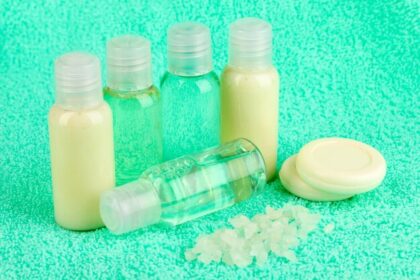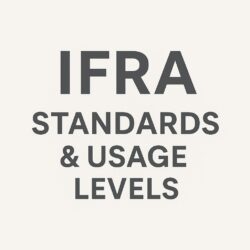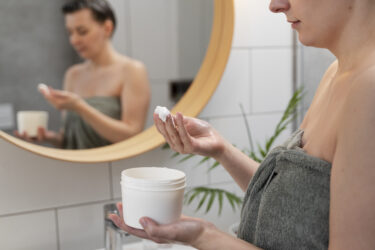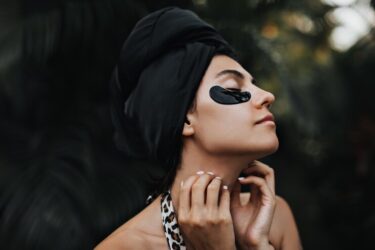Surfactants in Cosmetics:
Have you ever wondered how your shampoo creates that luxurious lather or why your moisturizer feels so silky? The secret lies in surfactants in cosmetics—the unrecognized heroes of cosmetic formulations. But with hundreds of surfactants available, how do you pick the right one for your product? This guide breaks down everything you need to know about surfactants in cosmetics, from their science to practical selection tips. Let’s dive in!
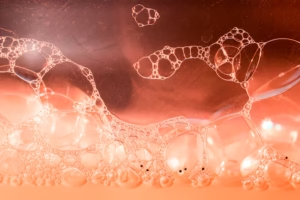
What Are Surfactants?
Surfactants (short for surface-active agents) are molecules that reduce surface tension between liquids, solids, or gases. In cosmetics, they act as cleansers, emulsifiers, foaming agents, and conditioners. Think of them as the multitaskers that make your products work smoothly.
Types of Surfactants Used in Cosmetics
Surfactants in cosmetics are classified into four main types based on their charge in a solution: anionic, nonionic, cationic, and amphoteric surfactants.
1. Anionic Surfactants
- These surfactants carry a negative charge in water, which makes them strong cleansers with excellent foaming properties.
Examples:
- Sodium Lauryl Sulfate (SLS) – A highly effective but strong detergent.
- Sodium Laureth Sulfate (SLES) – A milder alternative to SLS, with better skin compatibility.
Function:
- Provide deep cleansing by removing dirt, oil, and impurities.
- Create rich, stable foam for an enhanced washing experience.
Best For:
✔ Shampoos
✔ Body washes
✔ Facial cleansers
Drawback:
- Can be harsh on sensitive or dry skin, leading to irritation or stripping of natural oils.
- Learn about the mild surfactant, and benefits of Softan LS-30, a biodegradable anionic surfactant, and its applications in cosmetic formulations: Softan LS-30 – Biodegradable Anionic Surfactant.
2. Nonionic Surfactants
- These surfactants have no electrical charge, making them mild, pH-stable, and less irritating to the skin.
Examples:
- Decyl Glucoside – A biodegradable, plant-derived surfactant known for its mildness.
- Cetearyl Alcohol – A fatty alcohol that acts as an emulsifier and thickener in formulations.
Function:
- Provide gentle cleansing without disrupting the skin barrier.
- Help stabilize emulsions and improve texture in skincare and haircare products.
Best For:
✔ Baby products
✔ Sensitive skin formulations
✔ Sulfate-free shampoos
3. Cationic Surfactants
- These surfactants carry a positive charge, allowing them to bind to negatively charged hair and skin, making them excellent for conditioning.
Examples:
- Behentrimonium Chloride – A key conditioning agent that reduces frizz and enhances hair softness.
- Cetrimonium Chloride – Provides anti-static properties and improves detangling.
Function:
- Improve hair smoothness and manageability by neutralizing static electricity.
- Form a protective film on hair strands, preventing moisture loss.
Best For:
✔ Conditioners
✔ Hair masks
✔ Leave-in treatments
4. Amphoteric Surfactants
- These surfactants have both positive and negative charges, making them versatile and compatible with all surfactant types. They adjust their charge based on the pH of the solution.
Examples:
- Cocamidopropyl Betaine – A mild cleanser derived from coconut oil, often used to reduce the harshness of anionic surfactants.
- Sodium Lauroamphoacetate – A gentle, sulfate-free surfactant with excellent foaming properties.
Function:
- Provide mild cleansing while maintaining skin hydration.
- Enhance foam stability and reduce irritation caused by stronger surfactants.
Best For:
✔ Facial cleansers
✔ Sulfate-free shampoos
✔ Baby washes
By understanding these surfactant types, formulators can choose the right ingredients to create effective yet gentle cosmetic products tailored to different skin and hair needs.

How Surfactants Work in Cosmetics
Surfactants in cosmetics, are essential multifunctional ingredients in cosmetics, contributing to effective cleansing, luxurious foaming, stable emulsions, even dispersion of ingredients, and improved hair and skin conditioning. Understanding their roles helps formulators create balanced, high-performance products tailored to different needs.
Key Functions of Surfactants
1. Cleansing
- Surfactants trap and remove dirt, oil, and impurities from the skin and hair by forming micelles—tiny spheres that surround and lift away unwanted particles when rinsed with water.
Common Applications:
✔ Facial cleansers
✔ Shampoos
✔ Body washes
Example Ingredients:
- Sodium Lauryl Sulfate (SLS) – Strong cleansing with high foaming power.
- Decyl Glucoside – A mild, sulfate-free alternative for sensitive skin.
2. Foaming
- Surfactants help create a rich lather by reducing the surface tension of water, allowing air to be trapped within the formulation. This enhances the sensory experience of products like shampoos and body washes.
Common Applications:
✔ Shampoos
✔ Body washes
✔ Foaming facial cleansers
Example Ingredients:
- Cocamidopropyl Betaine – A gentle foam booster often combined with harsher surfactants to reduce irritation.
- Sodium Lauroyl Sarcosinate – Provides a creamy foam while being mild on the skin.
3. Emulsifying
- Emulsifiers (a type of surfactant) help mix oil and water, preventing separation in formulations like lotions and creams. They stabilize emulsions, ensuring a smooth and uniform texture.
Common Applications:
✔ Moisturizers
✔ Sunscreens
✔ Hair conditioners
Example Ingredients:
- Cetearyl Alcohol – A fatty alcohol that stabilizes oil-in-water emulsions.
- Polysorbate 60 – Helps blend oil-based and water-based ingredients evenly.
4. Solubilizing
- Solubilizing surfactants disperse small amounts of oil, fragrance, or essential oils into water-based products, ensuring an even distribution without visible separation.
Common Applications:
✔ Micellar water
✔ Toners
✔ Fragrance mists
Example Ingredients:
- Polysorbate 20 – Used to dissolve essential oils in water-based products.
- PEG-40 Hydrogenated Castor Oil – Helps solubilize fragrances and botanical extracts.
5. Conditioning
- Cationic surfactants (positively charged) bind to hair and skin, forming a thin protective layer that enhances softness, smoothness, and manageability while reducing static and frizz.
Common Applications:
✔ Hair conditioners
✔ Leave-in treatments
✔ Anti-frizz hair masks
Example Ingredients:
- Behentrimonium Chloride – A key conditioning agent in hair care.
- Cetrimonium Chloride – Improves detangling and reduces static.
How to Choose the Right Surfactant: A Step-by-Step Guide
Selecting the appropriate surfactants in cosmetics formulation is crucial to ensure efficacy, safety, and user experience. The right choice depends on several factors, including product type, skin and hair compatibility, and the Hydrophilic-Lipophilic Balance (HLB) system.
Factor 1 – Consider the Product Type
Different cosmetic products require surfactants with specific properties:
Cleansers (Shampoos, Face Washes, Body Washes):
- Best Choice: Anionic and amphoteric surfactants for their superior foaming and cleansing abilities.
- Example: Sodium Lauryl Sulfate (SLS) for deep cleansing, Cocamidopropyl Betaine for mildness.
Conditioners and Hair Treatments:
- Best Choice: Cationic surfactants to condition, detangle, and reduce static.
- Example: Behentrimonium Chloride to enhance hair softness and smoothness.
Emulsions (Creams, Lotions, Serums):
- Best Choice: Nonionic surfactants to stabilize oil and water phases.
- Example: Cetearyl Alcohol to enhance texture and stability.

Factor 2 – Skin and Hair Compatibility
Different skin and hair types react differently to surfactants. Choosing the right one can prevent irritation and enhance product performance.
Sensitive or Dry Skin:
- Best Choice: Mild nonionic or amphoteric surfactants that cleanse without stripping natural moisture.
- Example: Decyl Glucoside (gentle, plant-derived) and Sodium Lauroamphoacetate (non-irritating).
Oily or Acne-Prone Skin:
- Best Choice: Stronger anionic surfactants that effectively remove excess oil and buildup.
- Example: Sodium Laureth Sulfate (SLES) for deep cleansing without excessive dryness.
Factor 3 – The HLB System
(Hydrophilic-Lipophilic Balance)
The HLB system determines whether a surfactant is more water-loving (hydrophilic) or oil-loving (lipophilic), guiding its use in emulsions and cleansers.
Low HLB (3–6) – Oil-Soluble:
- Best for: Water-in-Oil (W/O) emulsions, rich creams, and balms.
- Example: Sorbitan Oleate, which helps blend oils into formulations.
Medium HLB (7–9) – Balanced:
- Best for: Lotions and medium-weight emulsions.
- Example: Glyceryl Stearate, commonly used for stable emulsions.
High HLB (10–18) – Water-Soluble:
- Best for: Cleansers, foaming products, and Oil-in-Water (O/W) emulsions.
- Example: Polysorbate 20, which helps dissolve essential oils in water-based products.
Here’s a simplified, reader-friendly HLB Chart inspired by Crodabeauty’s guide to help you match surfactants with your cosmetic product’s needs. This chart aligns with the Hydrophilic-Lipophilic Balance (HLB) system, which determines whether a surfactant is water-soluble, oil-soluble, or balanced for specific functions like cleansing, emulsifying, or conditioning.
HLB Chart for Surfactant Selection in Cosmetics:
| HLB Range | Surfactant Type | Primary Function | Example Surfactants | Best For |
| 1–3 | Oil-Soluble | Antifoaming, W/O Emulsifiers | Sorbitan Oleate, Glyceryl Stearate | Heavy creams, anhydrous balms |
| 4–6 | Lipophilic (Oil-Loving) | Water-in-Oil (W/O) Emulsifiers | Sorbitan Monostearate, Beeswax | Cold creams, sunscreen SPF |
| 7–9 | Balanced | Wetting Agents, Stabilizers | Cetearyl Alcohol, Cetyl Alcohol | Lotions, serums |
| 10–12 | Hydrophilic (Water-Loving) | Oil-in-Water (O/W) Emulsifiers | Polysorbate 20, Steareth-20 | Lightweight moisturizers, toners |
| 13–15 | Highly Hydrophilic | Cleansing, Detergents | Sodium Lauryl Sulfate (SLS) | Shampoos, body washes |
| 16–18 | Water-Soluble | Solubilizers, Foaming Agents | Decyl Glucoside, Cocamidopropyl Betaine | Facial cleansers, micellar water |
For a detailed understanding of the HLB (Hydrophilic-Lipophilic Balance) system and its role in surfactant selection, go to Croda’s HLB Guide Brochure.
How to Use This HLB Chart
The Hydrophilic-Lipophilic Balance (HLB) system helps formulators choose the right emulsifiers and surfactants for stable cosmetic formulations. Each product type requires a specific HLB range to ensure proper emulsification and functionality.
1. Identify Your Product Type
Cleansers (HLB 13–18):
- Require high HLB surfactants that are strongly water-soluble.
- Ensures effective removal of oil, dirt, and impurities.
- Example: Sodium Lauryl Sulfate (SLS), Polysorbate 20.
Emulsions:
- Water-in-Oil (W/O) Emulsions (HLB 4–6):
- Use low HLB emulsifiers to disperse water droplets in an oil phase.
- Example: Glyceryl Stearate, Sorbitan Oleate.
- Oil-in-Water (O/W) Emulsions (HLB 10–12):
- Use higher HLB emulsifiers to disperse oil droplets in a water phase.
- Example: Polysorbate 80, Ceteareth-20.
Learn more about Polysorbate 80, a versatile emulsifier and surfactant, in this detailed guide: Polysorbate 80 – Versatile Emulsifier & Surfactant.
- Water-in-Oil (W/O) Emulsions (HLB 4–6):
Conditioners (HLB 1–3):
- Require oil-soluble emulsifiers to stabilize silicones and oils.
- Helps deposit conditioning agents onto hair strands for softness and shine.
- Example: Cetearyl Alcohol, Stearamidopropyl Dimethylamine.
2. Combine Surfactants for Stability
For optimal emulsion stability, blend surfactants with different HLB values to reach the desired balance.
✅ Example (O/W Emulsion – Lotion):
- Use a low-HLB emulsifier (e.g., Glyceryl Stearate, HLB 3.8) to anchor oil into the formulation.
- Pair it with a high-HLB emulsifier (e.g., Polysorbate 80, HLB 15) to stabilize the water phase.
- This combination helps form a stable, uniform lotion without separation.
3. Test for Stability
- Adjust ratios based on formulation needs, such as:
- pH levels – Some emulsifiers work best in acidic or alkaline conditions.
- Temperature sensitivity – Some surfactants break down at high heat.
- Ingredient interactions – Check for compatibility with oils, thickeners, and active ingredients.
By carefully selecting and balancing emulsifiers using the HLB system, you can create stable, effective, and high-performing cosmetic formulations.
Pro Tips
- Griffin’s HLB Scale: Focuses on nonionic surfactants. Ionic surfactants (e.g., SLS) have fixed HLB values.
- Natural Formulations: Use plant-derived surfactants like Decyl Glucoside (HLB 14) for sulfate-free products.
Why Does HLB Matter?
The Hydrophilic-Lipophilic Balance (HLB) system is a numerical scale (ranging from 0 to 20) that determines how well a surfactant balances between water-loving (hydrophilic) and oil-loving (lipophilic) properties. Choosing the right HLB value is essential for ensuring a surfactant performs its intended function effectively in formulations.
1. High-HLB Surfactants (16–18)
Cleansers & Detergents
- Surfactants with a high HLB value (16–18) are highly water-soluble, making them ideal for lifting and removing oil, dirt, and impurities from the skin or hair.
Function:
- Help dissolve oil-based residues, making them effective in face washes, shampoos, and household cleaners.
- Create rich foam and improve the spreadability of cleansing formulations.
Best For:
✔ Facial cleansers
✔ Body washes
✔ Shampoos
✔ Micellar waters
Example Ingredients:
- Polysorbate 20 – A mild emulsifier and solubilizer used in cleansing products.
- Sodium Lauryl Sulfate (SLS) – A strong detergent that removes heavy oils and buildup.
2. Low-HLB Surfactants (4–6)
Emulsifiers for Creams & Lotions
- Surfactants with a low HLB value (4–6) are more oil-soluble, meaning they help blend oil and water together, preventing separation in formulations.
Function:
- Act as emulsifiers, stabilizing creams, lotions, and rich formulations.
- Ensure a smooth texture, enhancing the feel and consistency of skincare products.
Best For:
✔ Heavy creams
✔ Moisturizing lotions
✔ Oil-based serums
✔ Water-in-oil (W/O) emulsions
Example Ingredients:
- Glyceryl Stearate – A natural emulsifier used in rich creams.
- Sorbitan Stearate – Helps stabilize water-in-oil emulsions, making them thicker and more hydrating.By understanding HLB values, formulators can select the right surfactants to create effective cleansers, emulsions, and other cosmetic products that deliver optimal stability and performance
Factor 4 – pH Stability
pH stability is crucial in cosmetic formulations, as surfactants perform optimally within specific pH ranges. Using them outside their ideal range can lead to reduced effectiveness, instability, or potential irritation.
Anionic Surfactants (negatively charged) – Function best in mildly alkaline to neutral pH (>5.5). Lower pH levels can reduce their foaming and cleansing ability.
- Example: Shampoos and body washes typically maintain a pH around 5.5–7 to ensure effective cleansing without excessive irritation.
Cationic Surfactants (positively charged) – Prefer a slightly acidic pH (3–5), as this enhances their conditioning and anti-static properties.
- Example: Hair conditioners and leave-in treatments often have a pH between 4–5 to maintain hair smoothness and prevent frizz.
Factor 5 – Sustainability & Safety
With growing demand for eco-friendly and non-toxic formulations, choosing sustainable surfactants is essential for meeting “clean beauty” standards.
Avoid Ethoxylated Surfactants – Surfactants like Sodium Laureth Sulfate (SLES) undergo ethoxylation, which may introduce trace amounts of 1,4-dioxane, a potential contaminant. Products marketed as “clean beauty” or “sulfate-free” often exclude these ingredients.
Opt for ECOCERT or COSMOS-Approved Surfactants – These certifications ensure that surfactants are derived from renewable, biodegradable sources and meet strict safety standards.
- Example: Alkyl Polyglucosides (APGs), such as Decyl Glucoside and Coco-Glucoside, are mild, biodegradable, and commonly used in natural skincare and baby products.
Natural vs. Synthetic Surfactants: What’s Better?
| Parameter | Natural Surfactants | Synthetic Surfactants |
| Source | Plant-based (e.g., coconut oil) | Lab-derived (e.g., SLS) |
| Mildness | Gentler on skin | Can be harsh |
| Biodegradability | High | Variable |
| Cost | Higher | Lower |
Ideal Choice: Blend natural surfactants with mild synthetics for cost-effectiveness and performance.
Safety Considerations for Surfactants
Irritation Risks
- High Risk: SLS, Ammonium Lauryl Sulfate.
- Low Risk: Decyl Glucoside, Cocamidopropyl Betaine.
Regulatory Compliance
- EU Regulations: Ban or restrict surfactants like Sodium Lauryl Sulfate in leave-on products.
- FDA Guidelines: Require safety assessments for synthetic surfactants.
FAQs About Surfactants in Cosmetics
H3: 1. What’s the safest surfactant for sensitive skin?
A: Nonionic surfactants like Decyl Glucoside or Lauryl Glucoside are mild and eczema-friendly.
H3: 2. Can I mix different surfactants?
A: Yes! Combining anionic + amphoteric surfactants (e.g., SLES + Cocamidopropyl Betaine) improves mildness and lather.
H3: 3. Are sulfate-free surfactants effective?
A: Absolutely. Sulfate-free options like Sodium Lauroyl Methyl Isethionate offer gentle yet effective cleansing.
H3: 4. How do I test surfactant compatibility?
A: Conduct patch tests and check pH stability. Use tools like the HLB calculator for emulsifiers.
Final Tips for Surfactant Selection
- Start with your product’s primary function (cleansing, conditioning, etc.).
- Prioritize safety—avoid allergens like Cocamide DEA.
- Test small batches before scaling up.
Conclusion:
Choosing the right surfactant isn’t rocket science—it’s about balancing performance, safety, and sustainability. Whether you’re crafting a sulfate-free shampoo or a silky moisturizer, this guide equips you with the knowledge to make informed decisions. Ready to create your next bestselling product? Start experimenting!
For an in-depth look at emulsifiers in cosmetics, their functions, and how to choose the right one for your formulation, check out this comprehensive guide: Emulsifiers in Cosmetics.
